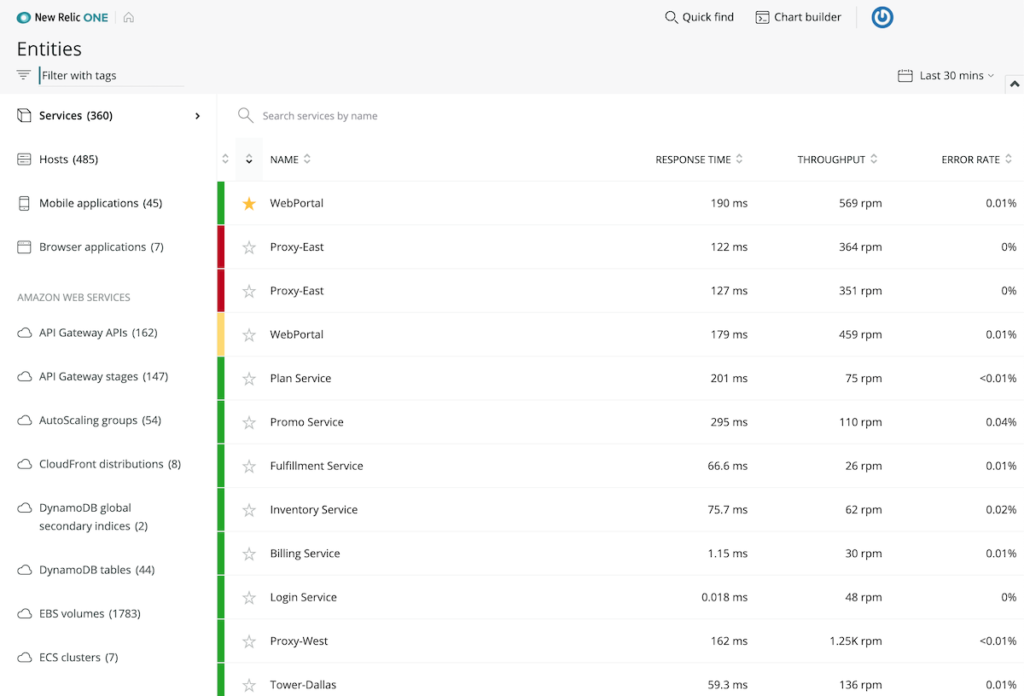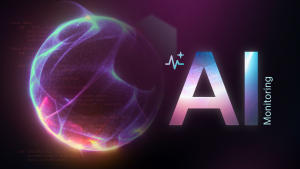New Relic One is the industry's first entity-centric observability platform. But what does it mean to be “entity-centric,” and why is it so important?
 In a word: context. Put simply, an entity is anything in your modern software environment that is a source of data you want to monitor. Being “entity-centric” means we connect you to all the data you need to understand your increasingly complex and interdependent systems in the context of your digital business. It’s a critical update to the “application-centric” approach we’ve always taken, because in complex modern software systems, there is so much more to worry about than just applications.
In a word: context. Put simply, an entity is anything in your modern software environment that is a source of data you want to monitor. Being “entity-centric” means we connect you to all the data you need to understand your increasingly complex and interdependent systems in the context of your digital business. It’s a critical update to the “application-centric” approach we’ve always taken, because in complex modern software systems, there is so much more to worry about than just applications.
What it means to be entity-centric
The way you build software is more complex than it has ever been—the game has changed, and you’re no longer simply monitoring applications and hosts. In the modern software world, every piece of data has a source, and every source is an entity. An entity can be something you monitor directly, like applications and microservices; or indirectly, like data centers. An entity emits data, and that data provides context about the internal state of the entity.
Types of entities include:
- Applications
- Services
- Instances of applications or services
- Hosts
- Containers
- AWS Lambda functions
- Virtual machines
- Cloud host instances
- Kubernetes clusters
- Cloud services
- Queueing systems
- Databases
- Synthetic monitors
- Cloud integrations, such as AWS Elastic Load Balancing or Amazon EC2
Things that are NOT entities include:
- Traces
- Individual Lambda executions
- Individual data types, such as events, metrics, or logs
Modern software systems are typically composed of large numbers of diverse, interdependent components, and each of them plays an essential role in delivering the solutions you build. This means that entities have dependencies; they seldom run in isolation. For many teams, the reliability of their own entities is dependent on other entities, owned by other teams. If a given entity is sick, it often affects many other entities.
An effective observability platform must be able to see across all of these interdependencies.
The importance of an entity-centric approach
To truly understand modern software systems, you need a solution that lets you look at each entity in context. You need to view each entity individually, and those views must be relevant to the way you work. That could mean viewing a service map that shows you connections across organizational boundaries, or a quick view filtered to the team or environment you care about.
In a larger sense, an entity-centric approach is all about viewing your systems in terms of business outcomes. Each entity in your system exists for a reason: It does a job, accomplishes a unit of work, or serves a unique business purpose. An entity-centric approach encompasses all of the entities that come together—quickly, efficiently, and reliably—to enable your teams to deliver great digital customer experiences.
How New Relic is entity-centric
For New Relic, being entity-centric means presenting data from the perspective of entities and their relationships. The New Relic platform is already broad enough to monitor virtually any kind of entity, from Java backend services to the lightest of AWS Lambda functions.
Being entity-centric is what separates New Relic from monitoring providers who take a metric-centric approach. These vendors may also provide a lot of metrics and data, but they lack context. Too often, they leave it to the operator to figure out if a particular metric value is good or bad and—more importantly—to discover where that metric is coming from.
Here’s the thing: Many metrics may be sub-optimal at any given time, but that doesn't mean you have to instantly optimize every part of your system. Instead of idly tuning numbers to seek perfection, focus your limited time and resources on the things that affect your business.
On the other hand, when things are failing or customers are unhappy, you need to know immediately which entity is the culprit. If you're awash in a sea of metrics without the appropriate context, you can’t see the cause of the problem, just the symptoms. As Cox Automotive Lead Software Engineer Matthew B. Vaughan, put it: “Other tools give me data, New Relic One gives me context.”
How it works
Modern digital systems comprise many different entities working together, and the New Relic One platform provides a clear, connected view of all your systems, teams, and technology. There is no work or toil involved in establishing and maintaining the relationships among those entities—New Relic One automatically creates and maintains visibility from the data you send us. You can quickly see the entities related to a problem, exposing possible root causes and what other systems might be affected. This lets you speed up troubleshooting, plan changes with confidence, and pinpoint where to optimize performance for the biggest impact on customer experience and other key business outcomes.
An entity is anything that reports data, so you'll find your entities wherever you see your data reporting in New Relic. To see a list of your monitored entities in New Relic One, select the entity explorer from the home page. (In New Relic APM 360 and New Relic Synthetics, you can use the GraphQL API to explore your entities).

The entity explorer gives you a unified view of every entity from all your New Relic accounts, as well as an organized navigation layer so you can see everything you monitor in one place, and quickly zoom into what you care about most. It's a fast way to find out if a service, a mobile app, or a cloud integration warrants further investigation.
Once you identify an entity of interest, the entity summary provides more information—including up- and downstream dependencies—so you can quickly decide if you need to dig deeper, or pan out to the broader view and explore more entities.

Putting it all together
Focusing on entities is the key to effectively monitoring complex, modern software systems at scale. You can’t improve what you don’t measure, and only New Relic has an “entity-centric” observability platform equipped to monitor all the things you need to track—as well as monitoring their increasingly fragmented interrelationships.
Unlike a “bag of metrics” monitoring approach that generates data in isolation without meaningful context, New Relic One’s holistic approach lets you know about everything in your system that’s generating data, as well as how it relates to all the other things you need to track. It's a uniquely powerful tool for creating more perfect software and making your business successful.
Learn more about New Relic One at https://newrelic.com/platform.
Additional New Relic One resources
本ブログに掲載されている見解は著者に所属するものであり、必ずしも New Relic 株式会社の公式見解であるわけではありません。また、本ブログには、外部サイトにアクセスするリンクが含まれる場合があります。それらリンク先の内容について、New Relic がいかなる保証も提供することはありません。



